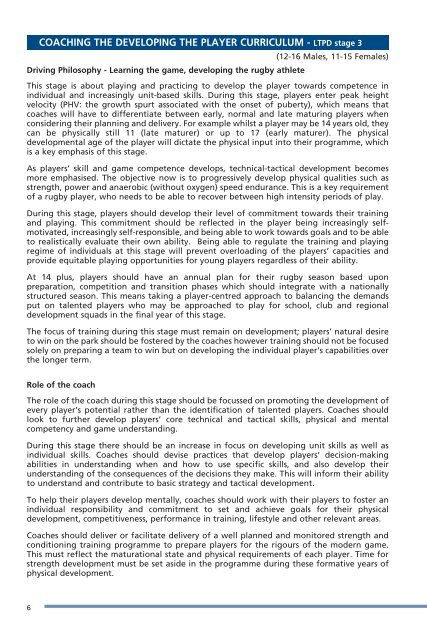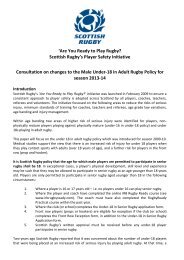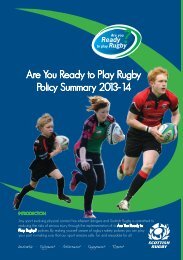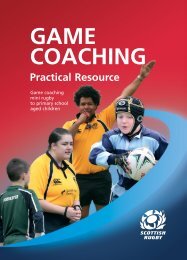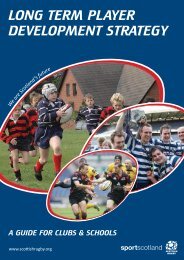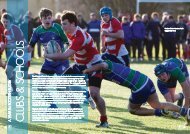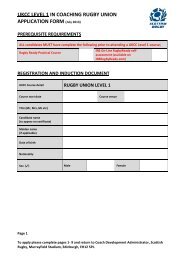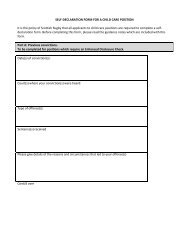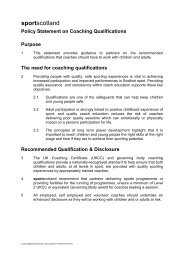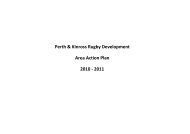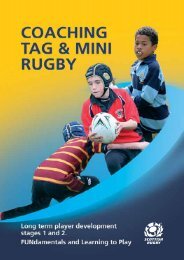LTPDst3cover.qxd (Page 1) - Scottish Rugby Union
LTPDst3cover.qxd (Page 1) - Scottish Rugby Union
LTPDst3cover.qxd (Page 1) - Scottish Rugby Union
- No tags were found...
Create successful ePaper yourself
Turn your PDF publications into a flip-book with our unique Google optimized e-Paper software.
COACHING THE DEVELOPING THE PLAYER CURRICULUM - LTPD stage 3(12-16 Males, 11-15 Females)Driving Philosophy - Learning the game, developing the rugby athleteThis stage is about playing and practicing to develop the player towards competence inindividual and increasingly unit-based skills. During this stage, players enter peak heightvelocity (PHV: the growth spurt associated with the onset of puberty), which means thatcoaches will have to differentiate between early, normal and late maturing players whenconsidering their planning and delivery. For example whilst a player may be 14 years old, theycan be physically still 11 (late maturer) or up to 17 (early maturer). The physicaldevelopmental age of the player will dictate the physical input into their programme, whichis a key emphasis of this stage.As players’ skill and game competence develops, technical-tactical development becomesmore emphasised. The objective now is to progressively develop physical qualities such asstrength, power and anaerobic (without oxygen) speed endurance. This is a key requirementof a rugby player, who needs to be able to recover between high intensity periods of play.During this stage, players should develop their level of commitment towards their trainingand playing. This commitment should be reflected in the player being increasingly selfmotivated,increasingly self-responsible, and being able to work towards goals and to be ableto realistically evaluate their own ability. Being able to regulate the training and playingregime of individuals at this stage will prevent overloading of the players’ capacities andprovide equitable playing opportunities for young players regardless of their ability.At 14 plus, players should have an annual plan for their rugby season based uponpreparation, competition and transition phases which should integrate with a nationallystructured season. This means taking a player-centred approach to balancing the demandsput on talented players who may be approached to play for school, club and regionaldevelopment squads in the final year of this stage.The focus of training during this stage must remain on development; players’ natural desireto win on the park should be fostered by the coaches however training should not be focusedsolely on preparing a team to win but on developing the individual player’s capabilities overthe longer term.Role of the coachThe role of the coach during this stage should be focussed on promoting the development ofevery player’s potential rather than the identification of talented players. Coaches shouldlook to further develop players’ core technical and tactical skills, physical and mentalcompetency and game understanding.During this stage there should be an increase in focus on developing unit skills as well asindividual skills. Coaches should devise practices that develop players’ decision-makingabilities in understanding when and how to use specific skills, and also develop theirunderstanding of the consequences of the decisions they make. This will inform their abilityto understand and contribute to basic strategy and tactical development.To help their players develop mentally, coaches should work with their players to foster anindividual responsibility and commitment to set and achieve goals for their physicaldevelopment, competitiveness, performance in training, lifestyle and other relevant areas.Coaches should deliver or facilitate delivery of a well planned and monitored strength andconditioning training programme to prepare players for the rigours of the modern game.This must reflect the maturational state and physical requirements of each player. Time forstrength development must be set aside in the programme during these formative years ofphysical development.6


